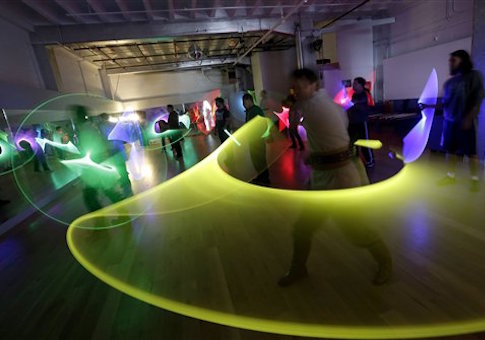The Food and Drug Administration (FDA) has toy lasers and lightsabers in its sights, issuing guidance to regulate the toys on Friday.
"Many a kid (and parent) who has seen Luke Skywalker battle Darth Vader with a lightsaber thinks lasers are cool," the government said in a blog post.
"What they may not know is this: When operated unsafely, or without certain controls, the highly-concentrated light from lasers—even those in toys—can be dangerous, causing serious eye injuries and even blindness."
"And not just to the person using a laser, but to anyone within range of the laser beam," the agency warned.
The FDA said they are "particularly concerned" about laser toys as the reason for issuing new rules for toy makers.
The FDA’s Center for Devices and Radiological Health (CDRH) "believes that toys containing lasers and lasers marketed as toys are particularly susceptible to being used in an unsafe or uncontrolled manner."
The guidance, aimed at manufacturers of laser products, limits the amount of light output a toy can emit to "Class I," set by the FDA. Class I are lasers that are "safe during use, including long-term direct intrabeam viewing, even when exposure occurs while using optical viewing instruments (eye loupes or binoculars)."
The FDA is still in the process of imposing the emission limits on the toys through the regulatory process, but released the guidance as a recommendation for manufacturers.
The agency’s list of toys the rules would apply to include "lasers mounted on toy guns that can be used for ‘aiming;’ spinning tops that project laser beams while they spin; hand-held lasers used during play as ‘lightsabers;’ and lasers intended for entertainment that create optical effects in an open room."
"Toys with lasers are of particular interest to the FDA because it's often children who are injured by these products," according to Dan Hewett, health promotion officer at FDA's Center for Devices and Radiological Health.
"Because advertisers promote them as playthings, parents and kids alike may believe they're safe to use," Hewett warned.
Hewitt said lasers pointed directly into someone’s eye could cause lasting injuries.
"[L]aser injuries usually don't hurt, and vision can deteriorate slowly over time," the FDA said. "Eye injuries caused by laser light may go unnoticed, for days and even weeks, and could be permanent."
The FDA added that people should "never aim or shine a laser directly at anyone, including animals," and that staring directly into a toy laser is hazardous, "perhaps even more than staring directly into the sun."
When asked why the FDA is regulating toy lightsabers and lasers and not the Consumer Product Safety Commission (CPSC), the agency said they have the authority under the Federal Food, Drug, and Cosmetic Act.
The CPSC did recall hundreds of thousands of Star Wars light saber toys in 1999, due to a manufacturing flaw that could cause its batteries to rupture.
